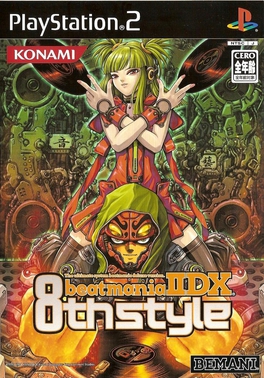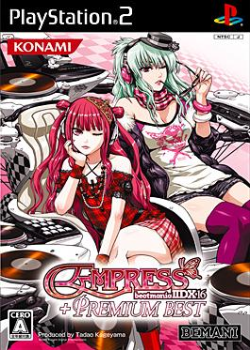Beatmania (ビートマニア) is a rhythm video game developed and distributed by Japanese game developer Konami and first released in December 1997. It contributed largely to the boom of music games in 1998, and the series expanded not only with arcade sequels, but also moved to home consoles and other portable devices, achieving a million unit sales. The Bemani line of music games from Konami is named after the series, was first adopted in the arcade release of Beatmania 3rdMix and kept ever since. The series came to an end with the last game being Beatmania The Final, released in 2002.

Beatmania IIDX (IIDX) is a series of rhythm video games, that was first released by Konami in Japan on 26 February 1999. Beatmania IIDX has since spawned 31 arcade releases and 14 console releases on the Sony PlayStation 2. It is the sequel to the beatmania game series, and is part of the Bemani line of music games.
Bemani, stylized as BEMANI, is Konami's music video game division. Originally named the Games & Music Division (G.M.D.), it changed its name in honor of its first and most successful game, Beatmania, and expanded into other music-based games, most notably rhythm games such as Dance Dance Revolution, GuitarFreaks, and DrumMania.

Keyboardmania is a rhythm video game created by the Bemani division of Konami. In this game up to two players use 24-key keyboards to play the piano or keyboard part of a selected song. Notes are represented on-screen by small bars that scroll downward above an image of the keyboard itself. The goal is to play the matching key when a note bar descends to the red play point line. The arcade cabinet has two screens - one for each player.

beatmania IIDX 10th Style is the tenth game in the beatmania IIDX series of music video games. It was released in arcades by Konami in early 2004.

Beatmania IIDX 9th Style is the ninth game in the beatmania IIDX series of music video games. It was released in arcades by Konami in 2003. The game features over 50 new songs, some of which can be unlocked using Konami's e-Amusement platform – which made its official debut on 9th Style.

beatmania IIDX 8th Style is a 2002 arcade game released by Konami. A PlayStation 2 version was released in 2004.

beatmania IIDX 7th Style is the seventh game in the beatmania IIDX series of music video games. It was released in arcades by Konami in March 2002.

Beatmania IIDX 6th Style is the sixth game in the beatmania IIDX series of music video games released in arcades by Konami in 2001 and features 40 new songs. 6th Style introduced new features such as letter grades and the new hard mode.

beatmania IIDX 5th Style is the fifth game in the beatmania IIDX series of music video games. It was released in arcades by Konami in 2001. The game features 35 new songs, five of which are hidden. New features introduced in this version are auto-scratch, as well as two more Hi-Speed settings 5th Style's songlist featured the first songs that would later become "flashing 7s", here differentiated from regular 7s with a kanji meaning "forbidden".

beatmania IIDX 3rd Style is a music video game developed by Bemani and published by Konami, initially released as an arcade game in Japan on February 25, 2000, and subsequently ported to the PlayStation 2 on November 2. 3rd Style removed the 4-keys mode from previous installments and replaced it with the Light7 difficulty, giving most songs a fully separate, easier notechart. The game also introduced Free Mode and Extra Stage, and featured a new aesthetic.
Beatmania IIDX Club Version was released on April 21, 1999 by Konami to the Japanese arcade audience. It could be linked with a Dance Dance Revolution machine for simultaneous play.
beatmania IIDX substream is a 1999 music video game which had a different songlist and could be linked to a Dance Dance Revolution machine for simultaneous play. If either the Dance Dance Revolution player or IIDX player made mistakes, the other game became more difficult.

Beatmania IIDX is an arcade music video game developed by Bemani and published by Konami. It was released in Japan on February 26, 1999. The objective is to perform songs using a controller with seven keys and a turntable. After the surprise success of Beatmania, Benami conceived IIDX to simulate an actual disc jockey (DJ) live performance. Its arcade cabinet contains a widescreen monitor, speakers, and eight spotlights. Bemani later developed several updated versions of IIDX to increased success. The game retrospectively received a positive reception from video game publications for its gameplay and increased difficulty. A sequel, Beatmania III, was released in 2000.

Beatmania IIDX 16: Empress is the 16th game in the Beatmania IIDX series of music video games. It was released in arcades by Konami on November 19, 2008. The game features over 50 new songs, some of which are unlocked over Konami's e-Amusement platform. The design of Empress's interface is based on a pink color scheme, dominated by sparkles, butterfly wings, and motifs of royalty and jewellery. A PlayStation 2 port for the game was released on October 15, 2009, in Japan.

Beatmania IIDX 17: Sirius is the 17th installment in Konami's Beatmania IIDX series of music video games. The main motif of Sirius's UI is astronomy, as the game is named after Sirius, known to be the brightest star in the night sky. Public location tests began on May 27, 2009, and the game itself was released on October 21, 2009.

Beatmania IIDX 18 Resort Anthem is a music video game in the Beatmania IIDX series of games by Konami. On April 19, 2010, Bemani fansite Zenius -I- Vanisher reported that Konami had announced the first location test for the newest game in the IIDX series. The location test ran from April 22 to April 26 at the Cat's Eye Machida (キャッツアイ町田) in Machida, Tokyo. Follow-up location tests ran in Chōfu, Tokyo and Kyoto from April 30 to May 6, in Nagoya and Sapporo from May 14 to May 20 and in Chiyoda, Tokyo from June 11 to June 12. The game was released on September 15, 2010 This Beatmania iteration's theme focuses heavily on a futuresque modern relaxation and tropical beach resort concert-like setting, with the interface making use of sleek mechanical components with simple whites and bright colors that are easy on the eyes.

Beatmania IIDX 19: Lincle is the 19th game in the beatmania IIDX series of music video games. The location test itself was announced on April 18, 2011. The location test was held first on Akihabara on April 20, 2011. Umeda's location test started on April 22, 2011, and both ended on April 25, 2011. Fukuoka and Nagoya had their location test started from April 28, 2011 until May 1, 2011. Kyoto and Sapporo's location test started on May 6, 2011 until May 8, 2011. It was released on September 15, 2011.

beatmaniaIIDX 20 tricoro is a music video game and the 20th installment of the Beatmania IIDX series of video games. It was first announced on April 14, 2012. Location tests began in Akihabara and Osaka on April 18 and 20, 2012 respectively. Both ended on April 24, 2012. It was released on September 19, 2012 for new cabinets and September 25, 2012 for upgrade kits of old machines. This is the 1st game that requires an internet connection for startup.
















